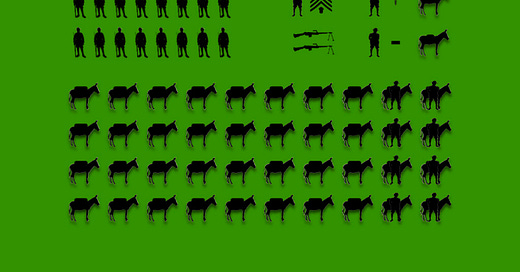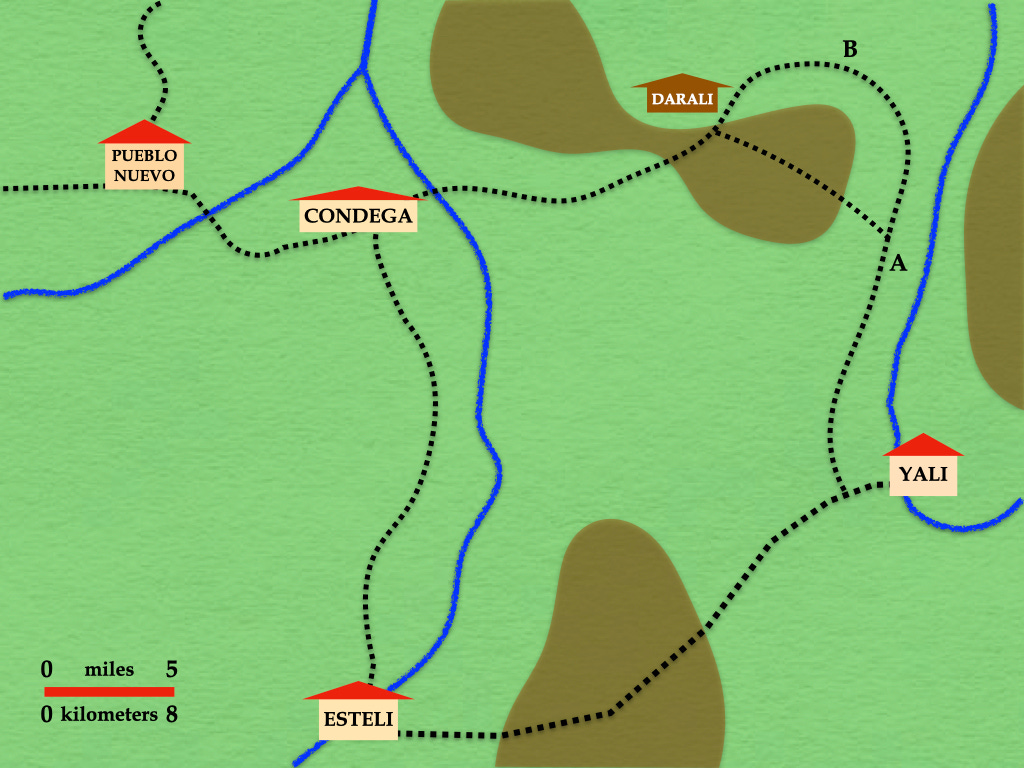Written by Lieutenant Harold D. Harris, USMC, this problem appeared in Volume XI (January 1936) of the Infantry School Mailing List and Volume 21, Number 11 (November 1938) of The Leatherneck.
At dawn on 27 February 1928, a pack train, convoyed by a Marine patrol, pushes out of Estelli, Nicaragua, along the trail to Yali, loaded with supplies for the company of Marines on outpost duty there.
The train consists of forty pack animals; and the patrol of three squads, a gunnery sergeant, one sergeant, a hospital corpsman, and a messenger, all under the command of a lieutenant. The last three are mounted, the remaining men on foot.
This is the first patrol for all the men, but they perform the job in an excellent manner. For in spite of the difficult terrain and the heavy mud of the trail they make the thirty miles to Yali in remarkable time, arriving just after dark.
The company of Marines at Yali was one of several units in the area engaged in the mission of maintaining order until a Nicaraguan force could be trained to take over that task. Now, the chief disturber of the peace was General Augusto César Sandino. He had been one of the leaders in the recent successful revolution. But when the fruits of victory were distributed Sandino felt that his portion was a lemon.
Accordingly he withdrew his forces to northern Nicaragua and placed himself in opposition to the government and the "Invaders", as he termed the Marines. Several bands of brigands in that area joined his banner so that he was nominally at the head of some thousand men. It was the threat of Sandino's band that forced the Marines to convoy all pack trains carrying supplies to their far-flung outposts.
Therefore, upon the safe arrival of the train and convoy at Yali, all hands felt that a perilous task had been well done and looked forward to a couple of day's rest before the return journey. But their hopes were shortly blasted, for they were no more than bedded down when orders came directing the patrol with its pack train to proceed at daylight the following morning to Condega, where another outpost company was stationed. Accordingly the patrol set out the next morning for Condega.
That village appeared, on the map available at the time, to be only some 12 miles from Yali. The day's march should be an easy one. But the trail was much more difficult than that of the preceding day, and men and animals were fagged out when the lieutenant halted his patrol about 1:30 PM near the road junction at A.
Upon inquiry there he learned to his consternation that he was still 17 miles from Condega. He then asked if there were any large ranches in the vicinity, and found that there was one at Darali. There were two roads to that point. One led over the mountain and was the shorter route to Condega; the second went through a defile but the going was easier.
Both roads were cut through heavy woods filled with dense undergrowth- potential ambush at many points. The lieutenant now considers the terrain, the roads, the condition of men and animals, the distance to Condega and the character of Sandino's band and comes to a decision.
Under conditions such as these, resembling as they do bush or jungle warfare, marches are normally made during daylight hours, starting after daybreak and ending in time to take adequate security provisions for the camp before dark.
You are the lieutenant. What do you decide to do?
This exercise serves neither as an argument for particular courses of action nor a criticism of decisions made in specific circumstances. Rather, it exists to give participants opportunities to immerse themselves in problems faced by a real person at some point in the past, and, in doing so, cultivate such martial virtues as decisiveness, critical thinking, creativity, situational awareness, and functional empathy.
The next step in this exercise is the presentation of the historical solution, which can be found here. If you wish to reap full benefit from this decision-forcing case, please refrain from reading the historical solution until you have come to a decision.
Please feel free to use the comment section to describe your solution to this problem. In doing this, please take care to avoid any information that would spoil the problem for your fellow readers.







The immediate priority is not being outside after dark in the jungle - never mind ambush, the attrition on our supplies would be catastrophic. So there are 3 options:
1. Route A to Darali
2. Route B to Darali
3. Retreat to Yali
Options 1 and 2 both carry an unknown risk of ambush, as we don't know either road as well as the enemy is likely to and we also have no way of knowing what if anything awaits us at Darali. Conversely, option 3 means extended delay in getting the supplies to Condega, whether we stay in Yali and attempt to get all the way in one day's march once recovered, or attempt to go the long way around via Esteli.
Decision: unless I knew when we set off that Condega were in imminent danger of abandoning their position due to lack of supplies I retreat, so as not to risk my tired force and valuable supplies over unknown territory in dwindling light. Once back I send out the message (either by runner or the same way we received the message telling us to hurry on after our arrival, I assume involving carrier pigeons or possibly radio?) that we were unable to proceed and Condega will require either a few days' wait or another convoy putting together from Esteli. If I know we may lose Condega for want of the convoy, we have no option but to push on - at least it doesn't sound like the pressure on Condega is a siege we're expected to fight our way into. Given the time of day and assuming the map in the problem is accurate, we're getting to Darali after dark if at all. Given the condition of the men, route A will be too hard going and is just as susceptible to ambush. I pick route B - at least it's easier going so we'll be in a fitter state to fight if it comes to it. Plus, if the enemy knows we know Condega is under threat, they may naturally assume we're making all possible haste and focus any efforts to stop us on the mountain path.
This is certainly a "damned if you do / damned if you don't" situation.
In short, I would make the hard push up and over the mountain and set in at the ranch as soon as possible.
At length: first I will calculate a hasty time-distance analysis. Using my rule of thumb for dismounts traversing mountain terrain /without/ roads, I'd expect about a half-mile's progress (800m) for every hour taking the mountain route. With a road, this time should be cut down significantly, but I'd expect a steep grade and lots of mud. The distance looks to be about five miles, so, I'll assume somewhere between five and eight hours to get across the mountain to the ranch. Regardless, it will be well and dark by the time of our arrival.
The likelihood of enemy contact is hard to discern, so I will deploy my lead team just barely within visual contact of my main body in a travelling overwatch. Where possible, I will instruct them to fan out and break brush along the sides of the road some distance, rather than walk directly on the road. I will have them strip down to just their combat equipment, and leave all sustainment and any extra weight with the pack animals. At the front of the main body I will have the remaining team from my lead squad, followed by an additional squad, equipped similarly. The two BARs will be in front of and behind this second squad. Third squad will be responsible for rear and flank security, and the pack animals.
Should the lead team take contact, I will be able to maneuver my Bravo team from first squad, as well as my second squad in its entirety. Should it be necessary, one of my sergeants will be able to establish a support by fire using the two BARs on the flank of any of my elements. The other sergeant will stay with the rest of the main body.
Maneuver will be very difficult in this terrain and fighting is likely to be very close up; all the more reason for the lead team to fan out wide. The other three teams will likely end up filing out perpendicular to the trail in one direction or another to support the lead team, and will be limited in their ability to flank at all. Fact is, there's no good way to fight up a steep slope, you just have to commit to it with violence and speed.
There's no chance in hell that I'd take that defile. We would be observed the entire way, even with the thick brush, and vulnerable the entire way. At least by taking the mountain road (which almost certainly follows the spine of the hill) after the peak we will command the hill. And, while on our way up, we will command the slopes to our flanks. It's generally better to just "get high and stay high." You aren't going to be able to hide with that kind of convoy anyways, best to just own the hill.